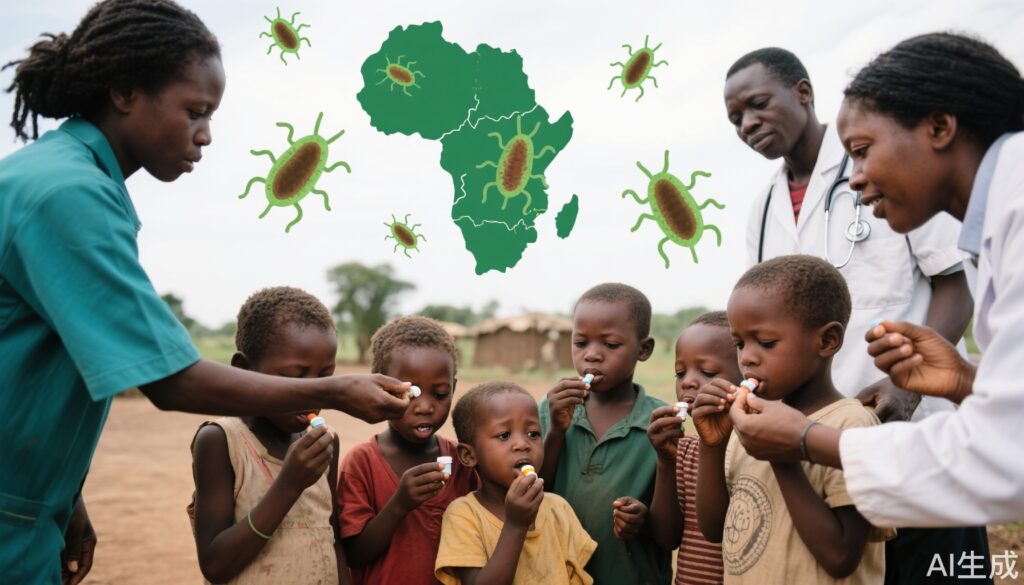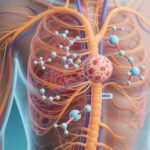Highlights
- Both sulfadoxine-pyrimethamine plus amodiaquine (SPAQ) and dihydroartemisinin-piperaquine were highly effective for seasonal malaria chemoprevention (SMC) in Ugandan children, reducing malaria risk by 94% and 96%, respectively.
- Dihydroartemisinin-piperaquine was non-inferior to SPAQ in preventing malaria, expanding chemoprevention options for regions with high sulfadoxine-pyrimethamine resistance.
- No evidence of increased selection for drug resistance mutations was observed, and both regimens demonstrated excellent safety profiles.
- Continued surveillance of antimalarial resistance remains essential to sustain SMC efficacy in Eastern and Southern Africa.
Study Background and Disease Burden
Malaria remains a leading cause of morbidity and mortality in sub-Saharan Africa, particularly affecting children under five years. Seasonal malaria chemoprevention (SMC)—the intermittent administration of antimalarial drugs during peak transmission periods—has significantly reduced childhood malaria incidence in West Africa using a combination of sulfadoxine-pyrimethamine plus amodiaquine (SPAQ). However, the spread of sulfadoxine-pyrimethamine resistance in East and Southern Africa has raised concerns about the durability of SPAQ-based SMC in these regions. Uganda, especially the Karamoja subregion, continues to experience intense, seasonal malaria transmission, necessitating evaluation of alternative SMC regimens. Dihydroartemisinin-piperaquine, an artemisinin-based combination therapy, offers a potential alternative due to its efficacy and prolonged post-treatment prophylactic effect. This study addresses the urgent need to identify effective and sustainable chemoprevention strategies amid rising antimalarial resistance.
Study Design
This open-label, three-arm, cluster-randomised controlled trial was conducted in the Karamoja subregion of Uganda. Eligible children were aged 3–59 months for SPAQ and 6–59 months for dihydroartemisinin-piperaquine. Of 427 eligible villages, 380 were randomised to either SPAQ or dihydroartemisinin-piperaquine, while 47 served as controls (no SMC). The trial was designed to address two primary hypotheses:
- Superiority: Both SPAQ and dihydroartemisinin-piperaquine would be superior to no SMC in preventing malaria.
- Non-inferiority: Dihydroartemisinin-piperaquine would be non-inferior to SPAQ in efficacy.
The primary endpoint was the incidence of confirmed clinical malaria (by rapid diagnostic test or microscopy). Secondary endpoints included molecular assessment of parasite resistance markers before and after five cycles of SMC and evaluation of adverse events. Survival analyses were conducted on an intention-to-treat basis, adjusting for baseline covariates.
Key Findings
A total of 3,881 children were enrolled: 1,755 in the SPAQ group, 1,736 in the dihydroartemisinin-piperaquine group, and 390 in the control group. Of these, 3,629 were included in the final analysis. The malaria incidence rates were dramatically lower in both intervention groups compared to controls:
- SPAQ: 0.90 cases per 100 person-months
- Dihydroartemisinin-piperaquine: 0.80 cases per 100 person-months
- Control: 18.26 cases per 100 person-months
Both SPAQ and dihydroartemisinin-piperaquine conferred substantial protection against malaria:
- SPAQ: Hazard ratio (HR) 0.06 (95% CI 0.04–0.08), p<0.001 (94% risk reduction)
- Dihydroartemisinin-piperaquine: HR 0.04 (95% CI 0.03–0.06), p<0.001 (96% risk reduction)
For the non-inferiority analysis (margin 1.4), dihydroartemisinin-piperaquine was non-inferior to SPAQ (HR 0.90, 95% CI 0.58–1.39), supporting its use as a viable alternative regimen.
Molecular analyses of 750 malaria-positive samples revealed high prevalence of mutations conferring moderate resistance to sulfadoxine-pyrimethamine (PfDHFR and PfDHPS >88%), but low prevalence (<5%) of markers associated with high-level resistance (PfDHFR Ile164Leu, PfDHPS Ala581Gly). Markers linked to amodiaquine resistance (PfMDR1 Asp1246Tyr, Asn86Tyr) were rare (<1%). Importantly, no significant increase in resistance-associated mutations was observed after five SMC cycles. Some alleles associated with aminoquinoline resistance (PfCRT Lys76Thr, PfMDR1 Asn86Tyr, Asp1246Tyr) even decreased in prevalence (p<0.001), suggesting that SMC did not select for resistance.
Safety was robust: no serious or fatal adverse events were reported. Both regimens were well-tolerated in the study population.
Expert Commentary
This landmark trial provides strong, context-specific evidence for the continued use of SPAQ-based SMC even in regions with moderate-to-high sulfadoxine-pyrimethamine resistance, as high-level resistance remains rare. The demonstration that dihydroartemisinin-piperaquine is non-inferior to SPAQ and similarly well-tolerated is highly relevant for policy-makers grappling with drug resistance in malaria-endemic settings. The robust cluster-randomised design, large sample size, and integration of molecular surveillance strengthen the validity and generalizability of these findings within East Africa.
However, the high prevalence of moderate resistance markers underscores the critical need for ongoing molecular surveillance and rapid response mechanisms should high-level resistance increase. The absence of resistance selection after one season is reassuring, but longer-term monitoring is warranted. Real-world implementation considerations—such as cost, acceptability, and supply chain logistics for dihydroartemisinin-piperaquine—will also influence scale-up decisions.
Conclusion
Both SPAQ and dihydroartemisinin-piperaquine are highly effective and safe for seasonal malaria chemoprevention in Ugandan children under five. Dihydroartemisinin-piperaquine offers a valuable alternative in settings threatened by sulfadoxine-pyrimethamine resistance. Policy decisions should be informed by ongoing resistance surveillance, operational feasibility, and further studies assessing long-term impact and cost-effectiveness. The study’s findings support immediate scale-up of SMC in Eastern and Southern Africa, with careful stewardship to preserve drug efficacy.
References
1. Nuwa A, Baker K, Kajubi R, Nnaji CA, Theiss-Nyland K, Odongo M, Kyagulanyi T, Nabakooza J, Salandini D, Asua V, Nakirunda M, Rassi C, Rutazaana D, Achuma R, Sagaki P, Bwanika JB, Magumba G, Yeka A, Nsobya S, Kamya MR, Tibenderana J, Opigo J. Effectiveness of sulfadoxine-pyrimethamine plus amodiaquine and dihydroartemisinin-piperaquine for seasonal malaria chemoprevention in Uganda: a three-arm, open-label, non-inferiority and superiority, cluster-randomised, controlled trial. Lancet Infect Dis. 2025 Jul;25(7):726-736. doi: 10.1016/S1473-3099(24)00746-1.
2. World Health Organization. WHO Policy Recommendation: Seasonal Malaria Chemoprevention (SMC) for Plasmodium falciparum malaria control in highly seasonal transmission areas of the Sahel sub-region in Africa. Geneva: WHO; 2012.
3. Yeka A, Gasasira A, Mpimbaza A, et al. Malaria in Uganda: challenges to control on the long road to elimination. I. Epidemiology and current control efforts. Acta Trop. 2012;121(3):184-95.



